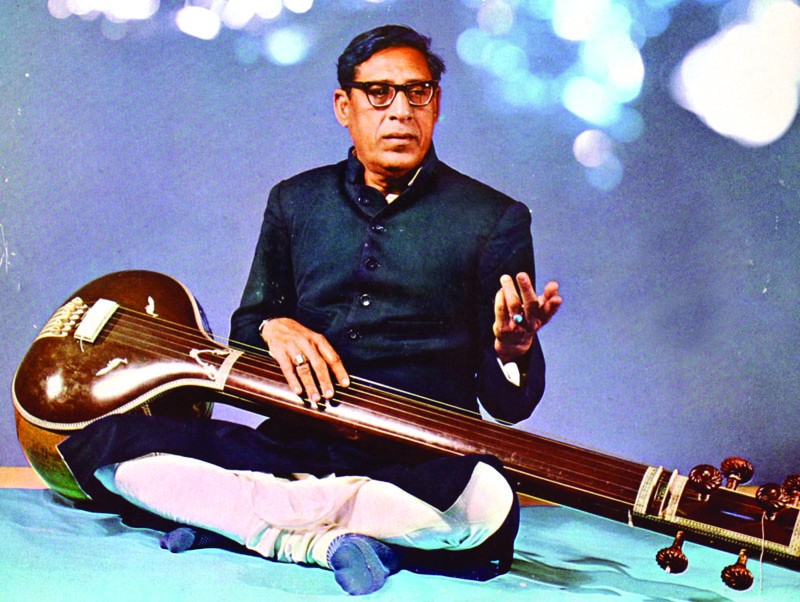
Ustad Amir Khan founded the Indore Gharana and his stylistic influence can still be seen in the works of many

Ustad Amir Khan was in his prime when he was killed in a car accident in 1974.
It is usually said that classical vocalists and instrumentalists mature late. Somewhere in their forties do they develop the confidence to integrate various stylistic features to stamp their own signature tunes on music. It has also often been said that many a musician or vocalist, including Tansen, bemoaned the fact that they had achieved the capability of performing only when they had become old and hence too fragile to sing or play to the best of their ability. "Music is a surging river and they have only been able to drink a drop" is a proverbial saying that sums up the impossible task of putting a benchmark on music.
Ustad Amir Khan’s presence was so dominant that it is said he founded a gharana, the Indore Gharana. In kheyal gaiki, gharanas were either named after the places the ustads hailed from or the state that patronised them. Unlike many other ustads, Amir Khan had many disciples and there were many others who were inspired by him and tried to emulate him and his music. The disciples include the likes of Pandit Amarnath and A. Kanan and his style has influenced many others including Bhimsen Joshi, Gokulotsavji Maharaj, Mahendra Toke, Piu Sarkhel, Prabha Atre, Rashid Khan, Rasiklal Andharia, Sanhita Nandi, Shanti Sharma, Nikhil Bannerji and Sultan Khan.
In Pakistan, Mubarak Ali sings in his ang. Mubarak Ali belongs to a long tradition of qawwals and, in his early days, did sing the qawwali. But then decades ago, he switched to singing the kheyal and adopted the ang of Ustad Amir Khan -- an unlikely choice because it is a style that does not espouse ready popularity and is not easily followed. All these years, Mubarak Ali has persisted with the style and has been appreciated. Many have also questioned the concept of adopting the ang of a master without becoming a formal shagird; for only after one is a shagird, one is certified to be a legitimate music heir to carry the legacy forward. Mubarak Ali never met the ustad and never had the privilege of listening to him live and in person but he was so smitten by the ang that he willed himself into being his shagird. He calls him a "rohani ustad", and has practiced in absentia all the rituals and rites peculiar to a traditional ustad shagird relationship. This bond which has had a quasi mystical quality about it is now weakening with the changes in society and the technological boom that has made exposure to all and sundry a fait accompli. Insularity that characterised ang and such traditions is now a thing of the past.
But Amir Khan was the vocalist for the highly initiated. He did away with what was and is considered a dictum -- that the artiste has to pander to popular sentiments and changing tastes for he shunned the over-embellishment and decorative motifs of singing and minimised the use of graces. He was true to the systematic exploration of the raag, the prescribed rules and the criteria laid for its expansion. He observed many rules and followed most faithfully thus presenting an example of gaiki which was as close to the text book as possible.
The most important influence in his gaiki was undoubtedly that of Ustad Abdul Wahid Khan, the virtuoso of the Kirana Gharana. He took up the same slow meticulous elaboration of the raag in the vilampat lai. It had a soothing touch that captivated the listener with its gradual building of the structure. It is also said that he was influenced by Rajab Ali Khan in his taans and Aman Ali Khan in the merukhand. Both the ustads of the Kirana Gharana, Abdul Wahid Khan and Abdul Karim Khan, made many innovations in the kheyal gaiki in the early part of the twentieth century but sadly this has not been properly documented. Ustad Karim Khan, it is said, initiated the singing of the sargam as part of the overall performance, not just a tool of riyaz in a correct stationing of sound and that he elaborated on the raag in the vilampat lai. The present parts of the kheyal singing were established by him. But the real credit for the elaboration of the raag in the slow tempo has often lain at the door of Ustad Waheed Khan. He was a past master at the correct intonation, which is to say that he could sing with the stress on the proper shruti and then explored the raag to its fullest possibility in that slow tempo or the vilampat layi.
Like many of the other top class kheyal gaiks, he was also the progeny of a sarangi player but the ang of the sarangi is not very visible in his gaiki. His father Shahmir Khan, a sarangi and veena player of the Bhindibazaar Gharana, served at the court of the Holkars of Indore and his grandfather, Changay Khan, was a singer in the court of Bahadur Shah Zafar. He had a younger brother, Bashir, who went on to become a sarangi player at the Indore station of the All India Radio. Actually what he did was that he kept his singing totally devoid of the colouration of sarangi. He often did not even sing to the accompaniment of sarangi; preferring the harmonium as he did not approve of the two melodic lines being sung and played almost simultaneously for the fear of collision of the two which would result in both cancelling each other out.
Ustad Amir Khan was awarded the Sangeet Natak Akademi Award in 1967 and the Padma Bhushan in 1971.
His barsi was on the 13th of February.